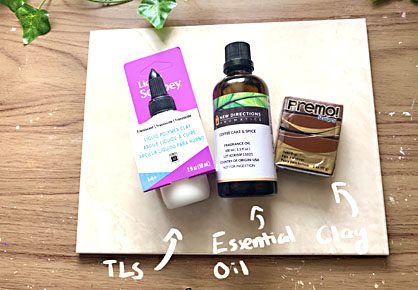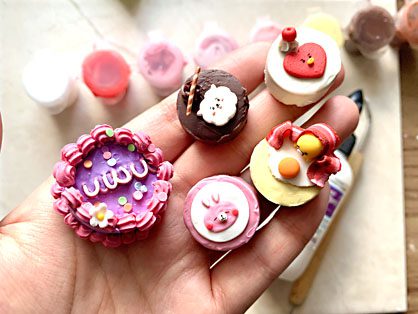Translucent Liquid Sculpey® (TLS) is one of my must-haves to use in conjunction with polymer clay, and for many reasons. It is extremely versatile in that it can be used to make fake sauces and icing, to soften clay, and as an adhesive. A little goes a long way and, like polymer clay, it will not air-dry and can be baked in the oven. I could rave all day about it, but instead, I will show you some of the most underrated techniques you can do with this material.
Adding Scent

Paint, chalk pastels, and glitter are all popular add-ons to TLS, but allow me to suggest one more: essential oils. You can make your chocolate cake charm smell like chocolate cake and your cereal figurine smell like cereal.

The method is extremely simple: add a few drops of your desired scent to your clay or liquid clay, mix it in, and bake as normal. This works best with sweets and pastries, but get creative and try different scents!
Here are a few things I’ve made that might spark your inspiration:

To conclude, allow me to dissipate some concerns you may have: essential oils are safe to mix and bake with polymer clay, the scent does not fade or change after baking it, and glazing it with Sculpey glaze will not cover the scent up.
Clay Softening
 It’s no secret that Liquid Sculpey® softens clay, but what I don’t see people do often is softening it when making icing and sauces. Oftentimes, people mix their clay and TLS together and end up with icing with lumps in it or expend far too much time and effort into making it smooth.
It’s no secret that Liquid Sculpey® softens clay, but what I don’t see people do often is softening it when making icing and sauces. Oftentimes, people mix their clay and TLS together and end up with icing with lumps in it or expend far too much time and effort into making it smooth.
 What I recommend is flattening out your clay until it’s a few millimeters thick, adding a dollop of TLS, and mixing it with your fingers until they’re fully combined. You do not need exact measurements for this tip, simply add a little at a time until the clay is stretchy and sticky, but still keeps its shape and doesn’t fully stick to your fingers.
What I recommend is flattening out your clay until it’s a few millimeters thick, adding a dollop of TLS, and mixing it with your fingers until they’re fully combined. You do not need exact measurements for this tip, simply add a little at a time until the clay is stretchy and sticky, but still keeps its shape and doesn’t fully stick to your fingers.
When you have the ideal consistency, add your clay into a mixing cup and stir in more Liquid Sculpey® as needed. What you will end up with is a much smoother mixture from far less effort. If you find that your fingers are sticky afterwards, you can clean them with a wet wipe!
Realistic Icing for Cake
 One last underrated use for Liquid Sculpey is realistic cake icing! I’ve seen aesthetic Korean lunch box cakes trending online and people making them out of spackling and caulking silicone, but none utilizing the perfect miniature food medium: polymer clay.
One last underrated use for Liquid Sculpey is realistic cake icing! I’ve seen aesthetic Korean lunch box cakes trending online and people making them out of spackling and caulking silicone, but none utilizing the perfect miniature food medium: polymer clay.
Making the icing is simple, and you can use the previous tip to create your perfect, smooth frosting. I recommend a consistency that is thin enough to be spread like cream cheese but thick enough to hold most of its texture.
 Take your base, which can be made of scrap clay, and place it on a surface you can turn around. I’m using a small disc made of epoxy resin.
Take your base, which can be made of scrap clay, and place it on a surface you can turn around. I’m using a small disc made of epoxy resin.
Apply a thin, even coat of icing until the entire surface is covered. Feel free to add more than you think is necessary!
 To make it resemble a real frosted cake, take a long craft blade or ruler, and scrape off the excess while rotating your cake. You can store the extra icing in a paint pot and save it for your next creation.
To make it resemble a real frosted cake, take a long craft blade or ruler, and scrape off the excess while rotating your cake. You can store the extra icing in a paint pot and save it for your next creation.
Then, decorate as you would like with more frosting or clay pieces and bake! This technique is simple but looks very realistic and is sure to give your miniatures a boost.

I hope you enjoyed these simple but effective tips on using Liquid Sculpey®! Now, go out there and create something amazing.


